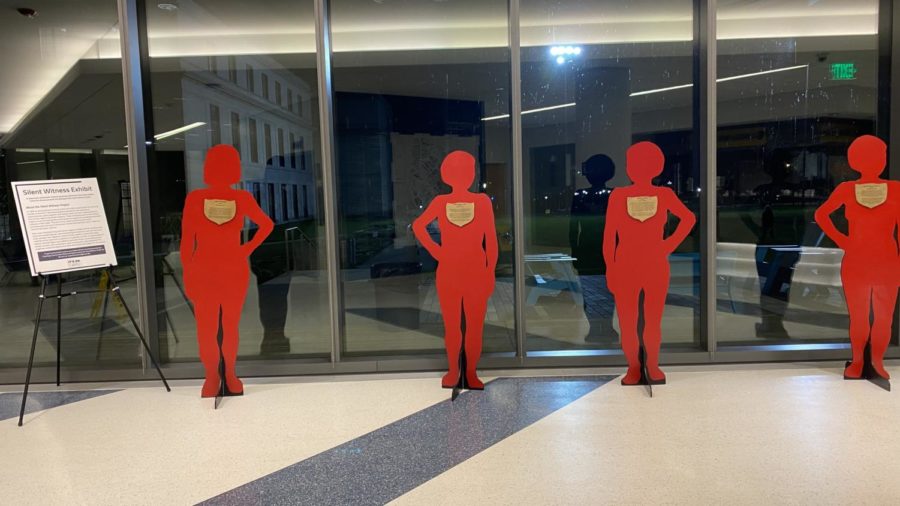Flora Stone Mather Center for Women displays Silent Witness figures
More than a statistic: figures call attention to the lives of domestic abuse victims, their families, their friends and their loved ones during Domestic Violence Awareness Month
November 5, 2021
Trigger warning: sexual violence, domestic violence.
In the Tinkham Veale University Center, close to the Koch entrance and right in front of the massive windows, stands a somber display of 11 life-size wooden cutouts of people, their bright red color eye-catching. Upon further inspection, these figures have wooden plaques affixed to them, each with the name of a woman and information about her life and her death at the hands of domestic violence. This display is a part of the Silent Witness Project, a national initiative intended to bring awareness to victims of domestic violence worldwide, and is on display in Tink during October, Domestic Violence Awareness Month.
Domestic abuse is a prevalent and urgent issue. According to the National Coalition Against Domestic Violence, one in four women and one in nine men have experienced physical violence, sexual violence or stalking by an intimate partner, and intimate partner violence accounts for 15% of all violent crime. From July 2019 to June 2020, 109 people, including four children, were victims of domestic violence homicides in Ohio. An important part of the fight against domestic violence is educating people on the issue and allowing them to see its impact, and that is exactly what the Silent Witness Project aims to do.
The project started in 1990 when a group of women writers and artists in Minnesota, upset about the growing number of women in their state being murdered by their intimate partners or other acquaintances, joined together with other women’s organizations to form the group Action against Domestic Violence. This group designed 26 wooden figures, each bearing the name of a woman whose life was cut short by a husband, former partner or acquaintance, with a 27th figure made to represent those whose murders remain unsolved or were declared accidental erroneously. These figures, called the Silent Witnesses, were first displayed at the Minnesota state capitol in February 1991, and since then the project has expanded dramatically. After the success of this display, 800 more witnesses were created in the span of a single year, and the movement is now international, present in all 50 states and in 23 different countries.
The Flora Stone Mather Center for Women, a campus office dedicated to defending gender equity on campus, has hosted this exhibit before in 2020. One of the center’s primary goals is to raise awareness of social issues and to advocate for change, and showing this exhibit on campus is an important part of that initiative. It serves as a call for students to recognize the impact of domestic violence on women who had families, friends, children and others who loved them and feel their loss keenly.
For anyone interested in checking out this exhibit during its last week on display, it is worth noting that the stories in the exhibit have extremely triggering and sensitive content, as they discuss domestic abuse, sexual and physical violence, murder and stalking. It features stories such as those of Leslie Sexton Waingrow, an insurance agent and mother of three who was shot and killed by her husband Todd, and Amber Nichole Jones, a dental assistant who, along with her three-year-old son, was shot and killed by her ex-boyfriend.
While these stories are extremely distressing to hear, the importance of giving a face and an identity to victims of domestic abuse cannot be undermined. Once you realize that those statistics of murder victims are more than numbers and, instead, account for real people with loved ones who cared for them, the significance of addressing domestic abuse becomes more clear. If you are able to, it is worthwhile to take a look at this exhibit and learn more about the lives of the Silent Witnesses.


